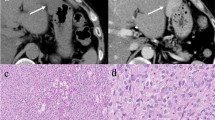Abstract
Purpose
The study aims to evaluate the risk of advanced histology within small colonic polyps and assess whether this risk warrants different recommendation for surveillance and treatment of such polyps.
Methods
A retrospective study of all patients undergoing their first ever colonoscopy and polypectomy in a tertiary hospital for one of three indications: screening, positive family history, and positive occult blood in stool. The histological reports of all resected polyps were retrieved and stratified according to the various polyps’ sizes. Advanced neoplasia was defined as tubular adenoma ≥10 mm or any size polyp with advanced histology, i.e., villous or tubulovillous adenoma, high-grade dysplasia, intramucosal carcinoma, or invasive cancer.
Results
Seven hundred forty-one patients who had a total of 1,192 resected polyps were included. Of polyps ≤5 mm in size, 1.6% harbored invasive cancer or high-grade dysplasia, and additional 4.1% contained villous component. The rate of advanced histology for polyps sized 6–9 mm was over 15%. The rate of advanced histology in polyps ≤5 mm was not significantly different when employing sensitivity analysis accounting for possible under or overestimation of polyp sizes by 1 and 2 mm. However, 4.6% of polyps sized 6–9 mm were found to harbor an invasive or high-grade dysplasia component when taken into account a 2-mm overestimation.
Conclusions
A non-negligible fraction of small polyps harbor advanced histology. This finding suggests that expectant follow-up by non-invasive colonic imaging modalities for small polyps or not reporting them may put more than 5% of patients at risk of dysplasia progression.
Similar content being viewed by others
References
Zalis ME, Barish MA, Choi JR, Dachman AH, Fenlon HM, Ferrucci JT, Glick SN, Laghi A, Macari M, McFarland EG, Morrin MM, Pickhardt PJ, Soto J, Yee J (2005) Working group on virtual colonoscopy. CT colonography reporting and data system: a consensus proposal. Radiology 236:3–9
Lieberman D, Moravec M, Holub J, Michaels L, Eisen G (2008) Polyp size and advanced histology in patients undergoing colonoscopy screening: implications for CT colonography. Gastroenterology 135(4):1100–1105
Graser A, Stieber P, Nagel D, Schäfer C, Horst D, Becker CR, Nikolaou K, Lottes A, Geisbüsch S, Kramer H, Wagner AC, Diepolder H, Schirra J, Roth HJ, Seidel D, Göke B, Reiser MF, Kolligs FT (2009) Comparison of CT colonography, colonoscopy, sigmoidoscopy and faecal occult blood tests for the detection of advanced adenoma in an average risk population. Gut 58(2):241–248
Rex DK, Overhiser AJ, Chen SC, Cummings OW, Ulbright TM (2009) Estimation of impact of American College of Radiology recommendations on CT colonography reporting for resection of high-risk adenoma findings. Am J Gastroenterol 104:149–153
Yoon H, Martin A, Benamouzig R, Longchampt E, Deyra J, Chaussade S, Groupe d’étude APACC (2002) Inter-observer agreement on histological diagnosis of colorectal polyps: the APACC study. Gastroenterol Clin Biol 26:220–224
Costantini M, Sciallero S, Giannini A, Gatteschi B, Rinaldi P, Lanzanova G, Bonelli L, Casetti T, Bertinelli E, Giuliani O, Castiglione G, Mantellini P, Naldoni C, Bruzzi P, Workgroup SMAC (2003) Interobserver agreement in the histologic diagnosis of colorectal polyps. The experience of the multicenter adenoma colorectal study (SMAC). J Clin Epidemiol 56:209–214
Winawer SJ, Zauber AG, Fletcher RH, Stillman JS, O’Brien MJ, Levin B, Smith RA, Lieberman DA, Burt RW, Levin TR, Bond JH, Brooks D, Byers T, Hyman N, Kirk L, Thorson A, Simmang C, Johnson D, Rex DK (2006) US Multi-Society Task Force on Colorectal Cancer; American Cancer Society. Guidelines for colonoscopy surveillance after polypectomy: a consensus update by the US Multi-Society Task Force on Colorectal Cancer and the American Cancer Society. Gastroenterology 130:1872–1885
Segnan N, Patnick J, von Karsa L (eds) (2010) European guidelines for quality assurance in colorectal cancer screening and diagnosis, 1st edn. Publication Office of the European Union, Luxembourg
Gopalswamy N, Shenoy VN, Choudhry U, Markert RJ, Peace N, Bhutani MS, Barde CJ (1997) Is in vivo measurement of size of polyps during colonoscopy accurate? Gastrointest Endosc 46:497–502
Schoen RE, Gerber LD, Margulies C (1997) The pathologic measurement of polyp size is preferable to the endoscopic estimate. Gastrointest Endosc 46:492–496
Morales TG, Sampliner RE, Gerwal HS, Fenerthy MB, Aickin M (1996) The difference in colon polyp size before and after removal. Gastrointest Endosc 43:25–28
Author information
Authors and Affiliations
Corresponding author
Rights and permissions
About this article
Cite this article
Shapiro, R., Ben-Horin, S., Bar-Meir, S. et al. The risk of advanced histology in small-sized colonic polyps: are non-invasive colonic imaging modalities good enough?. Int J Colorectal Dis 27, 1071–1075 (2012). https://doi.org/10.1007/s00384-012-1409-7
Accepted:
Published:
Issue Date:
DOI: https://doi.org/10.1007/s00384-012-1409-7




